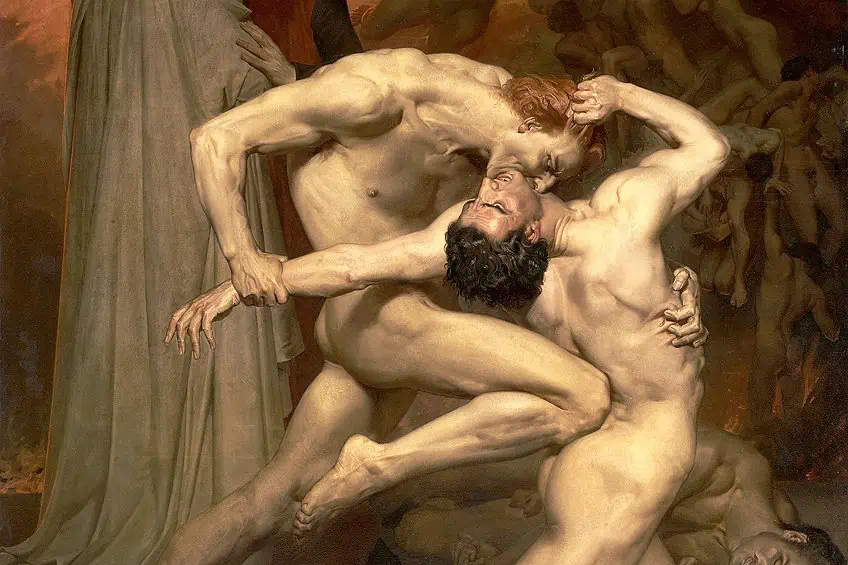“Dante and Virgil in Hell” by William-Adolphe Bouguereau – A Look
Inspired by the iconic Italian literary masterpiece, Divine Comedy, by Dante Alighieri, William-Adolphe Bouguereau is one such artist who established one of the most famous images of the Christian concept of hell, as inspired by Dante’s poem. In this article, we will unpack the famous painting Dante and Virgil in Hell by William-Adolphe Bouguereau, which will provide you with all the interesting details about the famous painting and its symbolism. Keep reading to learn more about the renowned Dante and Virgil painting!
Contents
An Introduction to Dante and Virgil in Hell by William-Adolphe Bouguereau
Most notions about the realm of hell were derived from Christian teachings and were previously associated with intangible and unfathomable visuals until the famed Italian poet Dante Alighieri penned his interpretation of hell in his groundbreaking publication of Divine Comedy. The story follows Dante’s journey through hell, alongside his guide and ancient Roman poet, Virgil, who takes him through a series of unsavory and unearthly experiences. This scene was immortalized in the painting we will dive into below, which was taken from a scene in Canto XXX.
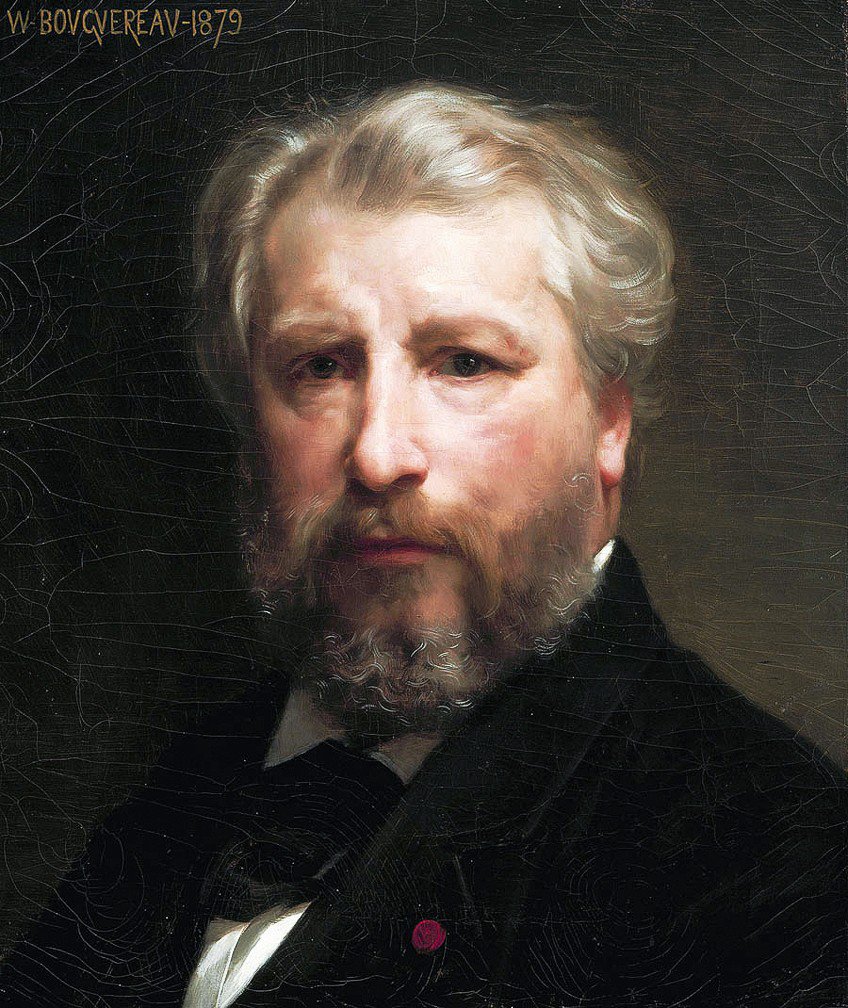
The artist behind the painting was a French author and Realist painter known as William-Adolphe Bouguereau. At the time, Bouguereau was recognized as the symbol of academic painting at the Salon itself and was also somewhat out of favor with the artists of the growing Impressionist movement. Among his strongest styles of painting were the female body, classical images, and mythology. Below, we will analyze the painting in further detail such that you will have a thorough understanding of the influence of Alighieri’s poem and the scene depicted in Dante and Virgil in Hell.
Dante and Virgil in Hell (1850) by William-Adolphe Bouguereau
| Artist Name | William-Adolphe Bouguereau (1825 – 1905) |
| Date | 1850 |
| Medium | Oil on canvas |
| Dimensions (cm) | 281 x 225 |
| Where It Is Housed | Musée d’Orsay, Paris, France |
Currently housed at the Musée d’Orsay in Paris, Dante and Virgil in Hell is perhaps one of the most striking and famous paintings of hell that was created by William-Adolphe Bouguereau in 1850. At first glance, the painting is representative of two muscular men who seem to quite literally be at each other’s throats. The men in the painting are also depicted with such great attention to realistic elements of their skin, musculature pull, and bodily contortion, such that it becomes an emotionally evocative painting.
Most great paintings make you feel something and Bouguereau’s depiction of this hell scene does just that.
What makes the painting so impactful is its context of production, which was born from Bouguereau’s ambition to win the prestigious Prix de Rome prize. Before he painted Dante and Virgil in Hell, he had already made two attempts to win the prize and as such, he thought that the third time would provide him with the luck he needed. In the creation of Dante and Virgil in Hell, Bouguereau strategically leaned on his knowledge of the scene, as one that would appeal to the judges of the competition.

Despite this, Bouguereau was unsuccessful in claiming the Prix de Rome but eventually saw success with his painting Shepherds Find Zenobia on the Banks of the Araxes, which earned him the consolation second prize. Below, we will dive into the Dante and Virgil in Hell meaning through visual analysis of the famous hell painting, including what it depicts, who is depicted, and the context of the scene.
Representation in Dante and Virgil in Hell (1850)
In Dante and Virgil in Hell, Bouguereau portrays a fight scene, which ensues while Virgil is leading Dante through one of the circles of hell. In the painting, Bouguereau depicts the two damned souls, which both Virgil and Dante observe as the two engage in a vicious and cut-throat battle known as eternal combat. The figures depicted include an alchemist and a heretic. The souls are eternally trapped in the battle and are recognized as Gianni Schicchi, the figure who bites down on Capocchio’s exposed neck. Why are these figures in hell?
While Capocchio was identified as a heretic, Schicchi was a known trickster, who conducted fraudulent activities to lay claim on another person’s inheritance.
To unpack the Dante and Virgil in Hell meaning, one must review what is represented in the scene, as well as its context. The scene itself was taken from The Inferno by Alighieri and describes a gruesome fight between the damned souls. Dante initially met Virgil, his guide, in the first Canto of the Divine Comedy, who led the way for Dante to navigate the terrifying encounters of purgatory.
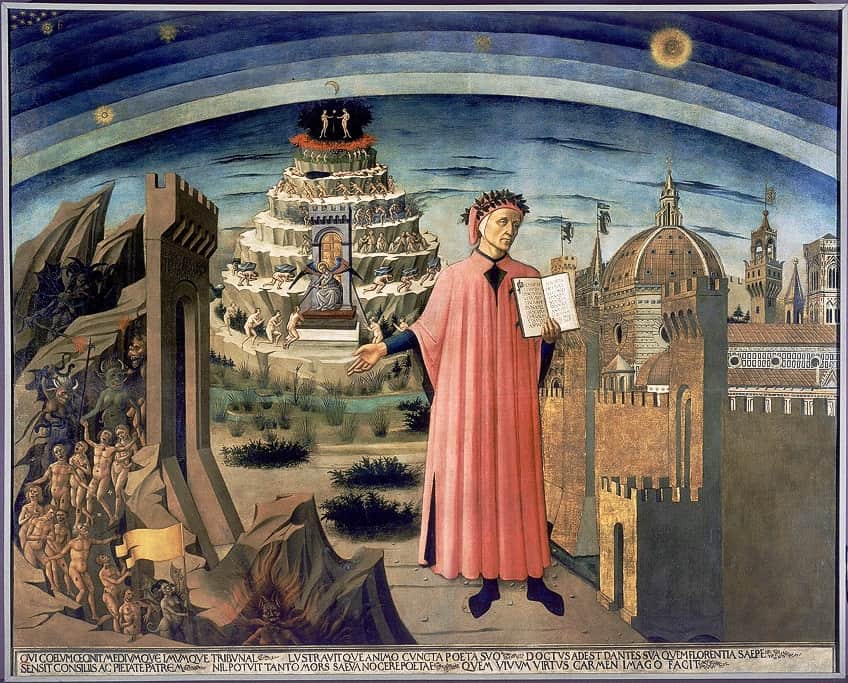
A description provided by Théophile Gautier stated that Schicchi threw himself at Capocchio, with an unusual fury, which was magnificently depicted in Bouguereau’s painting, from the nerves and tendons of their bodies to the atmosphere of brute strength, and bitterness. One can also spot Dante and Virgil in the shadows of the painting with other naked figures in the background and a strange, winged demon, whose eyes are cast on Dante and Virgil.
Contextual Analysis
We have already established that the literary context of the painting was backed by Alighieri’s 14th-century epic, which inspired Bouguereau to depict the scene from the eighth circle of hell. The eighth circle is believed to be the second last circle in the series of nine circles, through which Dante must pass. All nine circles represent different degrees of sin and in Bouguereau’s painting, we are immersed in the main scene that ensues in the eighth circle, where the deceased counterfeiters reside.
The name of the circle is Malebolge, which also means “evil pouches”, and is a unique level in hell that is encircled by a dull iron-hued stone with a valley divided into 10 additional pockets.
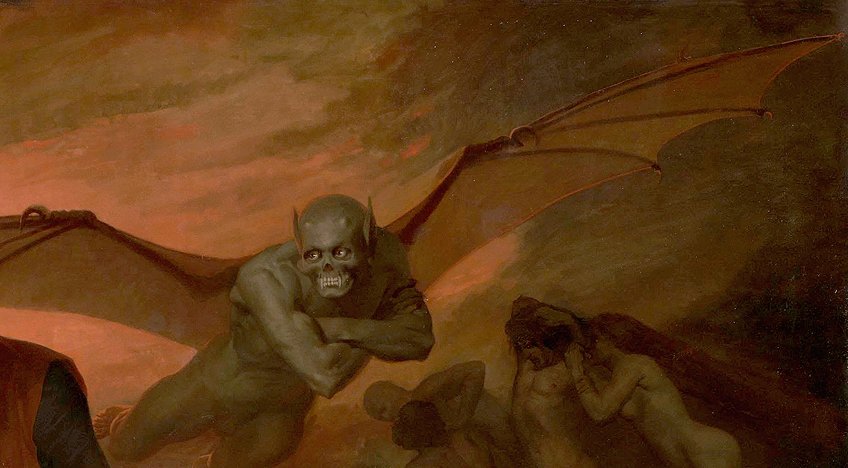
Bouguereau’s painting dives straight into the 10th pouch of the eighth circle to portray two men whom Dante was supposed to know. Capocchio was burnt at a stake in 1293 while Schicchi was condemned for stealing the identity of Buoso Donati and using it to amend his will in favor of himself. Buoso Donati’s family allegedly went on a rampage to search for his will but discovered that Donati left all his funds to local monks. His relatives employed the help of Gianni Schicchi, whose only talent was mimicry, to pretend to be Buoso Donati until death, before which he changed the will. Buoso Donati’s money-hungry relatives were left penniless in the end.
Style
The style of Bouguereau’s Dante and Virgil in Hell was executed in a Neoclassical style with the use of Realism on the figures and their musculature. The Neoclassical style emerged after the trends of Rococo and Baroque styles, which emphasized ornate decoration.
The Neoclassical style was inspired by the classical appearance and simplicity of Roman and Greek art, which can be spotted in Bouguereau’s depiction of figures, whose bodies seem almost idealized, despite their position in hell.

Color in Dante and Virgil in Hell
The use of color in the painting reflects the traditional deep and warm color palette that one would expect to find in an image of hell. What makes the painting truly shine is the color of the figures, who appear almost as pale as Greek and Roman marble statues. One is also drawn to the immaculate attention to detail on the color of the blood that slips from Capocchio’s ribs, as his opponent savagely grips his skin, tearing it apart with his brute force.
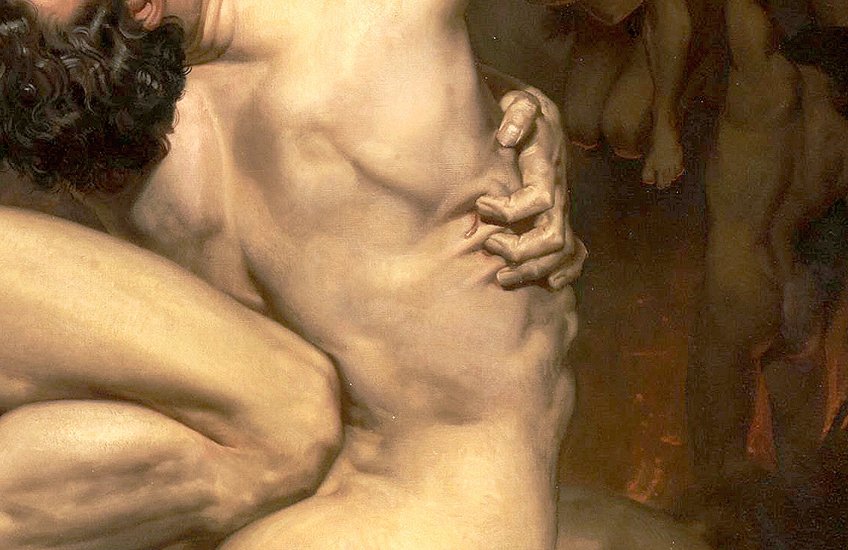
The color of the blood is not quite one of a person who is still living and one is made to watch the seemingly congealed blood trickle down. In this way, the viewer also feels the imagined pain of having one’s most vulnerable part of the human torso exposed and open to harm.
Formal Elements
When looking at the formal elements within Dante and Virgil in Hell, we notice that the main focus of the composition is drawn to the two damned souls who are engaged in a ferocious battle. Bouguereau’s use of light to illuminate the figures’ bodies was intentional in directing our attention toward the main scene and setting up a clear line of dominance. Another brilliant feature in the painting is Bouguereau’s depiction of the contorted body of Capocchio, whose torso is being pulled by his opponent as he is forced to bend over backward due to the force of Schicchi’s attack.
As such, Capocchio’s spine creates an interesting curvature that immediately makes the viewer uncomfortable.
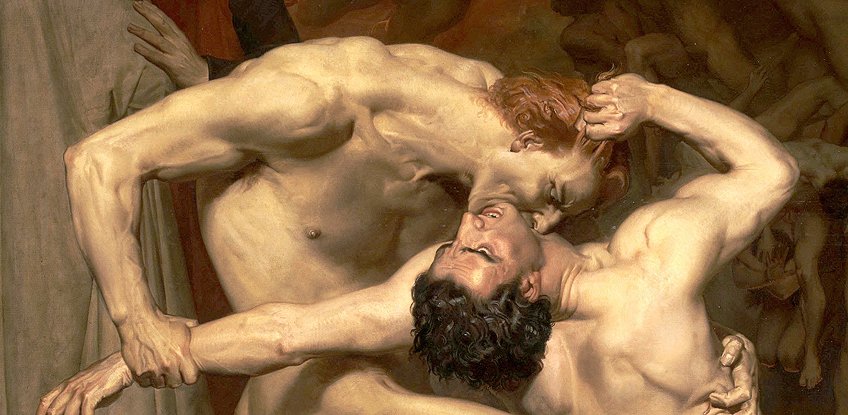
Bouguereau’s clever use of lines in the figures’ bodies also draws our attention to the two figures who juxtapose the curvature of Capocchio’s spine, Dante and Virgil. What adds to the impact of the work is that Bouguereau’s choice of title detracts from the main scene completely and depicts the main characters in the shadows, as bystanders. In this way, the painting conspires to highlight the feeling of brutality and relentless violence that Dante witnesses in the eighth circle.
Bouguereau’s application of atmospheric perspective is also emphasized to place the idealized nude figures in the foreground.

The winged demon is also spotted by following Dante’s eyes. The demon’s wings direct us to the far right of the composition, where one can spot the hoard of writhing figures. In the text, the character Dante is unable to consume the fury and violence of the scene, such that he often gets overstimulated. Luckily, Virgil guides Dante through the horrors of hell and provides him with a digestible perspective. Virgil does this to help Dante see clearer since he pitied all the souls he witnessed along the journey.
One of the best aspects of the painting is that it does not highlight the relationship between Dante and Virgil, rather alludes to Virgil’s protective nature over Dante and the scene that ensues. One is thus forced to confront the scene at hand.
Conclusions About the Dante and Virgil Painting
A curious question one might have about why Virgil was included in the scene is that the character was believed to have been born before Jesus Christ, hence he cannot truly partake in hell, however, he was known to be a pagan in his life and therefore is trapped in limbo and cannot enter heaven. This famous hell painting is undoubtedly one of the most visually striking and memorable hell paintings that paint a portrait of what one would expect to find in hell. In essence, the painting draws attention to the flaws of human existence in the way that we use the defining features that make us human to create our own suffering and those of others.
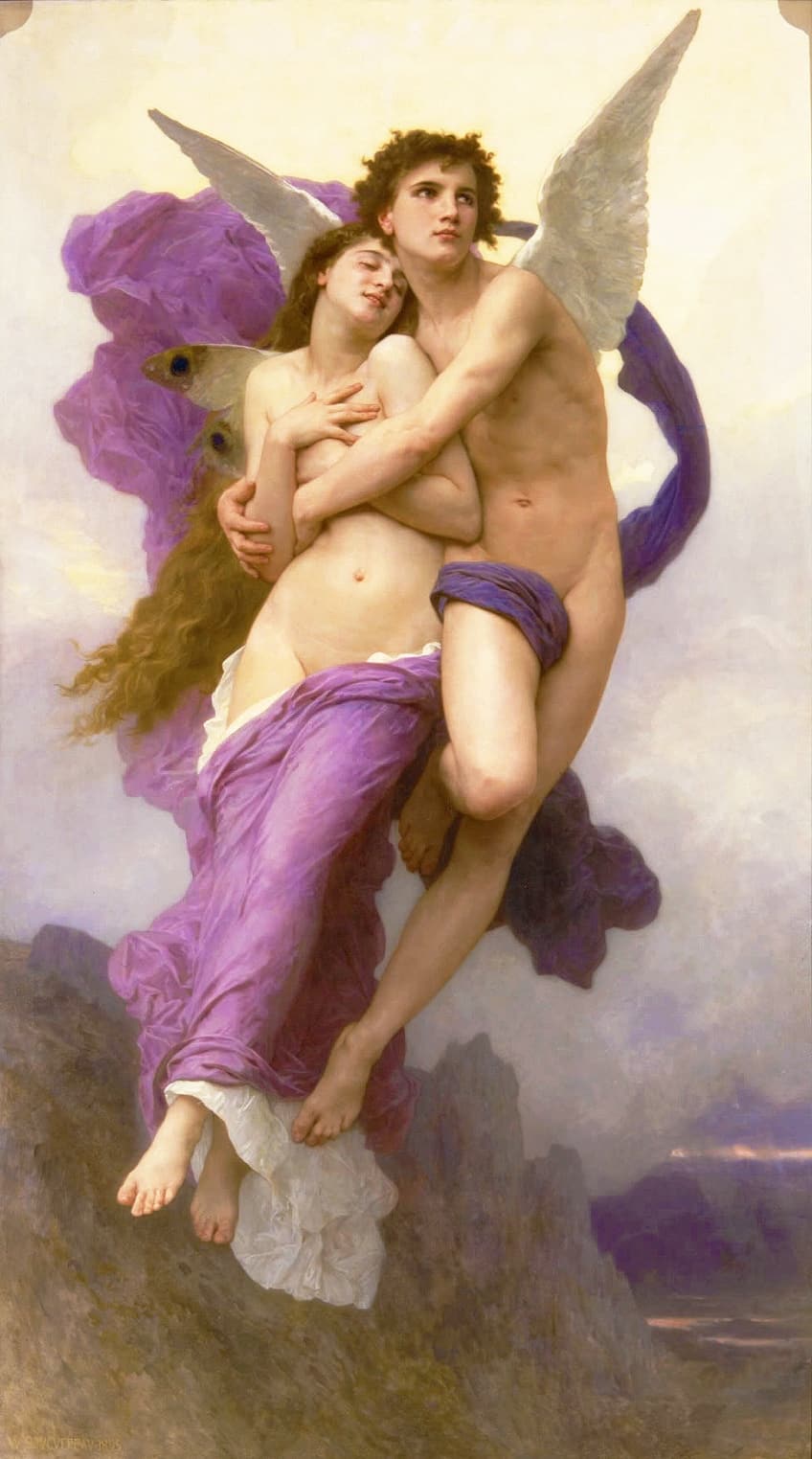
There are many gems to recover from the narrative embedded in this famous painting. From recognizing how one’s greed can contribute to our final judgment to unpacking the complexities of Christian beliefs that hold a certain level of influence on many people, there is much to be observed from hell paintings such as Dante and Virgil in Hell.
Frequently Asked Questions
Who Painted Dante and Virgil in Hell?
The famous hell painting known as Dante and Virgil in Hell was painted by the French Neoclassical and Realism painter, William-Adolphe Bouguereau, in 1850. Bouguereau was best known for his realistic representations of subjects in mythology, genre scenes, and modern interpretations of classical themes.
What Is the Painting Dante and Virgil in Hell About?
William-Adolphe Bouguereau’s painting, Dante and Virgil in Hell (1850), was based on a scene from Dante Alighieri’s Inferno, which highlights the eighth circle of hell, where Dante and his guide, Virgil, witness the brutality of a fight scene. The fight scene reflects the character of the eighth circle of hell, which is occupied by the damned souls who committed fraud or who were counselors of such activities that resulted in the downfall of other people.
When Was the Dante and Virgil Painting Created?
The iconic hell painting known as Dante and Virgil in Hell was created around 1850, and was identified as one of the artist’s most unique paintings of the era. It is currently part of a private collection housed at the Musée d’Orsay in Paris, France.
Jordan Anthony is a Cape Town-based film photographer, curator, and arts writer. She holds a Bachelor of Art in Fine Arts from the University of the Witwatersrand, Johannesburg, where she explored themes like healing, identity, dreams, and intuitive creation in her Contemporary art practice. Jordan has collaborated with various local art institutions, including the KZNSA Gallery in Durban, the Turbine Art Fair, and the Wits Art Museum. Her photography focuses on abstract color manipulations, portraiture, candid shots, and urban landscapes. She’s intrigued by philosophy, memory, and esotericism, drawing inspiration from Surrealism, Fluxus, and ancient civilizations, as well as childhood influences and found objects. Jordan is working for artfilemagazine since 2022 and writes blog posts about art history and photography.
Learn more about Jordan Anthony and about us.
Cite this Article
Jordan, Anthony, ““Dante and Virgil in Hell” by William-Adolphe Bouguereau – A Look.” artfilemagazine – Your Online Art Source. November 28, 2023. URL: https://artfilemagazine.com/dante-and-virgil-in-hell-by-william-adolphe-bouguereau/
Anthony, J. (2023, 28 November). “Dante and Virgil in Hell” by William-Adolphe Bouguereau – A Look. artfilemagazine – Your Online Art Source. https://artfilemagazine.com/dante-and-virgil-in-hell-by-william-adolphe-bouguereau/
Anthony, Jordan. ““Dante and Virgil in Hell” by William-Adolphe Bouguereau – A Look.” artfilemagazine – Your Online Art Source, November 28, 2023. https://artfilemagazine.com/dante-and-virgil-in-hell-by-william-adolphe-bouguereau/.


